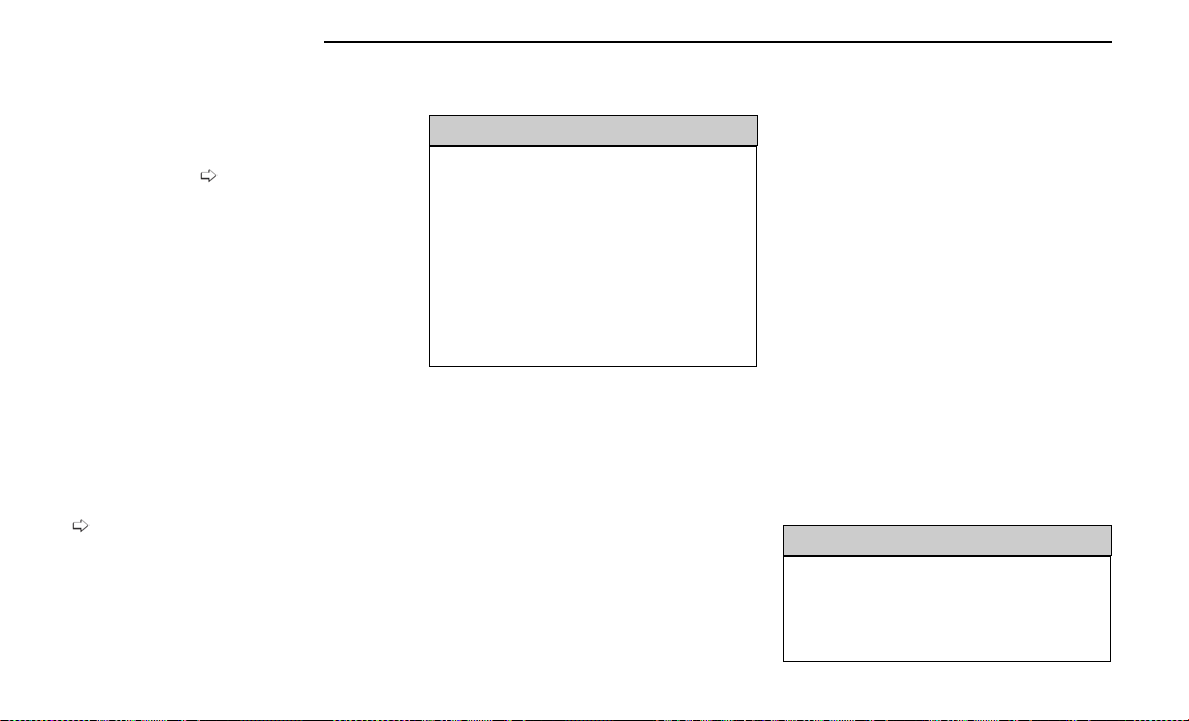Loading ...
Loading ...
Loading ...

NOTE:
If the gear selector is not in PARK, and the ENGINE
START/STOP button is pushed once with the vehicle
speed below 5 mph (8 km/h), the engine will shut off
and the ignition will remain in the ON/RUN position. If
vehicle speed drops below 1.2 mph (1.9 km/h), the
vehicle may AutoPark
page 114.
ENGINE START/STOP Button Functions — With Driver’s
Foot Off The Brake Pedal (In PARK Or NEUTRAL Position)
The ENGINE START/STOP button operates similar to an
ignition switch. It has two positions: OFF, and RUN. To
change the ignition positions without starting the
vehicle and use the accessories, follow these
directions:
1. Start with the ignition in the OFF position.
2. Push the ENGINE START/STOP button once to place
the ignition in the ON/RUN position.
3. Push the ENGINE START/STOP button a second time
to return the ignition to the OFF position.
NOTE:
Only press one pedal at a time while driving the vehicle.
Torque performance of the vehicle could be reduced if
both pedals are pressed at the same time. If pressure
is detected on both pedals simultaneously, a warning
message will display in the instrument cluster
page 92.
AUTOPARK
AutoPark is a supplemental feature to assist with plac-
ing the vehicle in PARK (P) should the situations on the
following pages occur. It is a back-up system and
should not be relied upon as the primary method by
which the driver shifts the vehicle into PARK.
The conditions under which AutoPark will engage are
outlined on the following pages.
WARNING!
•
Driver inattention could lead to failure to place the
vehicle in PARK. ALWAYS DO A VISUAL CHECK that
your vehicle is in PARK by verifying that a solid (not
blinking) “P” is indicated in the instrument cluster
display and on the gear selector. If the "P" indicator
is blinking, your vehicle is not in PARK. As an
added precaution, always apply the parking brake
when exiting the vehicle.
•
AutoPark is a supplemental feature. It is not
designed to replace the need to shift your vehicle
into PARK. It is a back-up system and should not
be relied upon as the primary method by which the
driver shifts the vehicle into PARK.
If the vehicle is not in PARK and the driver turns off the
engine, the vehicle may AutoPark.
AutoPark will engage when all of these conditions are
met:
•
Vehicle is equipped with an 8-speed transmission
•
Vehicle is not in PARK
•
Vehicle speed is 1.2 mph (1.9 km/h) or less
•
Ignition is switched from RUN to OFF
NOTE:
For Keyless Enter ‘n Go™ equipped vehicles, the engine
will turn off and the ignition switch will change to
ON/RUN position. After 30 minutes the ignition
switches to OFF automatically, unless the driver turns
the ignition switch OFF.
If the vehicle is not in PARK and the driver exits the
vehicle with the engine running, the vehicle may
AutoPark.
AutoPark will engage when all of these conditions are
met:
•
Vehicle is equipped with an 8-speed transmission
•
Vehicle is not in PARK
•
Vehicle speed is 1.2 mph (1.9 km/h) or less
•
Driver’s seat belt is unbuckled
•
Driver’s door is ajar
•
Brake pedal is not pressed
The message “ AutoPark Engaged Shift To P Then Shift
To Gear” will display in the instrument cluster.
NOTE:
In some cases the ParkSense graphic will be displayed
in the instrument cluster. In these cases, the gear
selector must be returned to “P” to select desired gear.
If the driver shifts into PARK while moving, the vehicle
may AutoPark.
AutoPark will engage ONLY when vehicle speed is
1.2 mph (1.9 km/h) or less.
The message “ Vehicle Speed Is Too High To Shift To P”
will be displayed in the instrument cluster if vehicle
speed is above 1.2 mph (1.9 km/h).
WARNING!
If vehicle speed is above 1.2 mph (1.9 km/h), the
transmission will default to NEUTRAL until the vehicle
speed drops below 1.2 mph (1.9 km/h). A vehicle left
in the NEUTRAL position can roll. As an added pre-
caution, always apply the parking brake when exiting
the vehicle.
114 STARTING AND OPERATING
Loading ...
Loading ...
Loading ...